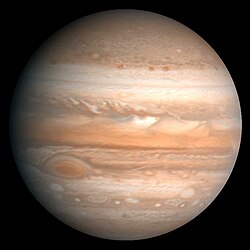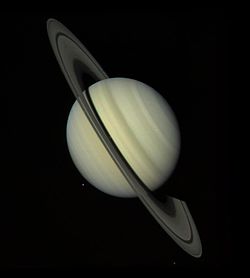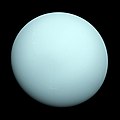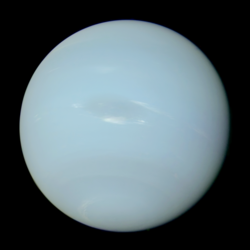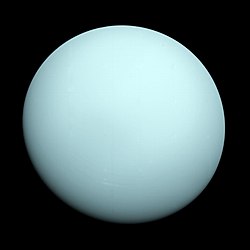Voyagerprogrammet
- För andra betydelser, se Voyager.
| Voyagerprogrammet | |
 | |
| Land | USA |
|---|---|
| Organisation | NASA |
| Status | Pågår |
| Historik | |
| Första rymdfärd | Voyager 2 |
| Sista rymdfärd | Voyager 1 |
| Plats(er) för uppskjutning | Cape Canaveral Air Force Station |
| Farkostinformation | |
| Farkosttyp | Rymdsond |
| Raket(er) | Titan 3E Centaur |

Voyagerprogrammet är ett program inom NASA som resulterade i två rymdfarkoster, Voyager 1 och Voyager 2 som sköts upp 5 september respektive 20 augusti 1977. Ursprungligen utgjorde de en del av Marinerprogrammet, men i mars 1977 döptes de om från Mariner 11 och 12, till Voyager 1 och 2.
Syfte
Syftet med projektet var främst att undersöka Jupiter och Saturnus för att ge tillräckligt material för senare rymdsonder till planeterna, samt undersöka rymden mellan planeterna. För Voyager 2 kom det även att omfatta Uranus och Neptunus. När sonderna närmade sig planeter kunde även små frekvensskillnader i radiosignalen användas för att bekräfta Albert Einsteins speciella relativitetsteori.
Bakgrund
Under mitten av 1960-talet kom astronomerna fram till att de yttre planeternas positioner framöver skulle göra det möjligt att skicka rymdsonder till flera av planeterna samtidigt och dessutom göra att mängden energi som krävdes skulle vara betydligt mindre än annars. Då det går cirka 175 år mellan varje gång samtliga de större planeterna befinner sig i samma riktning var det ett tillfälle de inte ville missa. Under 1968 började formella förberedelser göras genom att ett antal projekt för att utveckla behövlig teknik startade. Under 1970 började Outer Planets Missions Project planeras. Efter budgetproblem kunde det starta 1972 då döpt till Mariner Jupiter/Saturn 1977 Project.
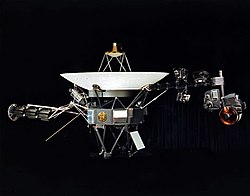
Farkosterna
Voyager 1 sköts upp den 5 september 1977. På sin väg ut ur solsystemet passerade den Jupiter (1979) och Saturnus (1980).
Voyager 2 sköts upp den 20 augusti 1977. På sin väg ut ur solsystemet passerade den Jupiter (1979), Saturnus (1981), Uranus (1986) och Neptunus (1989).
I början av 2025 hade farkosterna ett avstånd av 25 respektive 21 miljarder kilometer från Jorden. Elektriska signaler behöver en tid av 19,5 respektive 23 timmar för sträckan. För att fortsätta med missionen avslutades några program som fanns i början. Så sparas energi från plutoniumbatterierna.[1]
Se även
Källor
- James Watt International Gold Metal Lecture: The Voyager Spacecraft, Heacock, R. L.
Externa länkar
 Wikimedia Commons har media som rör Voyagerprogrammet.
Wikimedia Commons har media som rör Voyagerprogrammet.
| |||||||||||||||||||||||||||||||||||||||||||||||||
| ||||||||||||||||||||||||||||
| |||||||||||||||||||||||||||||||||||||||||
| |||||||||||||||||||||||||||||||||||||||
| |||||||||||||
Media som används på denna webbplats
NASA photograph of one of the two identical Voyager space probes Voyager 1 and Voyager 2 launched in 1977.
The 3.7 metre diameter high-gain antenna (HGA) is attached to the hollow ten-sided polygonal body housing the electronics, here seen in profile. The Voyager Golden Record is attached to one of the bus sides.
The angled square panel below is the optical calibration target and excess heat radiator.
The three radioisotope thermoelectric generators (RTGs) are mounted end-to-end on the left-extending boom. One of the two planetary radio and plasma wave antenna extends diagonally left and down, the other extends to the rear, mostly hidden here. The compact structure between the RTGs and the HGA are the high-field and low-field magnetometers (MAG) in their stowed state; after launch an Astromast boom extended to 13 metres to distance the low-field magnetometers.
The instrument boom extending to the right holds, from left to right: the cosmic ray subsystem (CRS) above and Low-Energy Charged Particle (LECP) detector below; the Plasma Spectrometer (PLS) above; and the scan platform that rotates about a vertical axis.
The scan platform comprises: the Infrared Interferometer Spectrometer (IRIS) (largest camera at right); the Ultraviolet Spectrometer (UVS) to the right of the UVS; the two Imaging Science Subsystem (ISS) vidicon cameras to the left of the UVS; and the Photopolarimeter System (PPS) barely visible under the ISS.
Suggested for English Wikipedia:alternative text for images: A space probe with squat cylindrical body topped by a large parabolic radio antenna dish pointing upwards, a three-element radioisotope thermoelectric generator on a boom extending left, and scientific instruments on a boom extending right. A golden disk is fixed to the body.NASA's Voyager 1 took this photograph of Saturn on Oct. 18, 1980, 34 million kilometers (21.1 million miles) from the planet. The photograph was taken on the last day that Saturn and its rings could be captured within a single narrow-angle camera frame as the spacecraft closed in on the planet for its nearest approach on Nov. 12. Dione, one of Saturn's inner satellites, appears as three color spots just below the planet's south pole. An abundance of previously unseen detail is apparent in the rings. For example, a gap in the dark, innermost ring, called the C-ring or crepe ring, is clearly shown. Material is seen within the relatively wide Cassini Division, separating the middle, B-ring from the outermost ring, the A-ring. The Encke Division is shown near the outer edge of the A-ring. The detail in the rings' shadows cast on the planet is of particular interest: the broad, dark band near the equator is the shadow of the B-ring; the thinner, brighter line is just to the south of the shadow of the less dense A-ring.
Författare/Upphovsman: NASA / Voyager 2 / PDS / OPUS / Ardenau4, Licens: CC0
Neptune on 1989-08-17, taken by NASA's Voyager 2 probe. This color image was composed of three frames, orange, green, and blue, taken by Voyager 2's imaging system. This color image has been calibrated to best represent Neptune's true color and appearance. Based on: Irwin, Patrick G J (2023-12-23). "Modelling the seasonal cycle of Uranus’s colour and magnitude, and comparison with Neptune". Monthly Notices of the Royal Astronomical Society 527 (4): 11521–11538. DOI:10.1093/mnras/stad3761. ISSN 0035-8711.
Original Caption Released with Image: This processed color image of Jupiter was produced in 1990 by the U.S. Geological Survey from a Voyager 2 image captured in 1979. The colors have been enhanced to bring out detail. Zones of light-colored, ascending clouds alternate with bands of dark, descending clouds. The clouds travel around the planet in alternating eastward and westward belts at speeds of up to 540 kilometers per hour. Tremendous storms as big as Earthly continents surge around the planet. The Great Red Spot (oval shape toward the lower-left) is an enormous anticyclonic storm that drifts along its belt, eventually circling the entire planet.
The Voyager 2 aboard Titan III-Centaur launch vehicle lifted off on August 20, 1977. The Voyager 2 is a scientific satellite that studied outer planets Jupiter, Saturn, Uranus, and Neptune.
This is an image of the planet Uranus taken by the spacecraft Voyager 2 in 1986. See Uranus.jpg for how Uranus would appear in visible light.
Artist's concept of Voyager in flight
The NASA insignia. Element RGB color values as defined in Encapsulated PostScript file obtained from the Publishing Office of NASA Glenn Research Center.
